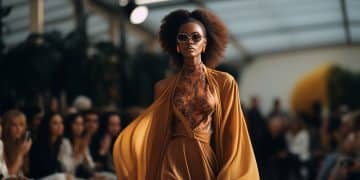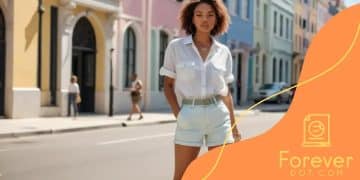Sustainable fashion events 2025: a glimpse into the future


Sustainable fashion invites us into a world where style harmonizes with responsibility. As the fashion industry pivots toward eco-conscious solutions, these transformative events in 2025 become more than gatherings, they’re catalysts for change.
Whether you’re an industry pro or a curious consumer, get ready to discover how green innovation, ethical approaches, and transparent practices are reshaping the future of fashion.
Key sustainable fashion events to attend in 2025
The year 2025 brings a rich lineup of sustainable fashion gatherings that blend creativity, education, and activism.
These events stand out not just for their runways but for their commitment to environmental responsibility, innovation, and collaboration.
Global Sustainability-Focused Fashion Weeks
Events such as Fashion Revolution Week continue to spark worldwide discussions about ethics and transparency in the industry.
Alongside it, Green Fashion Week promotes collections from eco-minded designers and introduces innovations that drastically reduce environmental impact.
The London Fashion Week: Sustainability Edition further elevates the conversation by requiring participating brands to meet stricter eco-friendly criteria.
Innovation and Material Science Showcases
The Biofabricate Conference in Paris is a highlight for anyone interested in the future of textiles, presenting breakthroughs like lab-grown fabrics, mushroom leather, and plant-based alternatives.
Similarly, the Future Fabrics Expo in London offers a curated look at next-generation sustainable materials, giving designers and brands tangible options for low-impact production.
Strategic Industry and Policy Summits
The Global Fashion Summit in Copenhagen gathers policymakers, investors, and creative leaders to shape long-term strategies for a low-carbon and circular industry.
Meanwhile, regional events like Walk Your Values in New York blend cultural programming with sustainability advocacy, and Obroni Wawu in Accra showcases African innovation in eco-conscious design.
Attending these gatherings gives participants the chance to learn from experts, explore cutting-edge materials, and network with a global community committed to transforming the future of sustainable fashion.
They are not just dates on the calendar but pivotal moments shaping the industry’s next chapter.
Impact of sustainable fashion on the industry
The influence of sustainable fashion extends far beyond runways, reshaping how clothing is designed, produced, and consumed.
As awareness of climate change, waste reduction, and ethical labor grows, both consumers and brands are rethinking their priorities. This shift is creating lasting transformations in business models, market expectations, and cultural values.
Economic and Business Transformation
Sustainable fashion is driving a fundamental restructuring of the market. Many brands are adopting the circular economy, designing products for reuse, repair, and recycling.
This reduces raw material dependency and opens up new revenue streams, such as resale platforms and take-back programs.
According to industry trend reports, companies that lead in sustainability often see stronger brand loyalty and higher retention rates, as customers actively seek eco-conscious alternatives.
The movement also generates new jobs in areas like green manufacturing, ethical sourcing, and regenerative farming for textile fibers.
Consumer Behavior and Quality Standards
Shoppers are increasingly turning away from disposable fast fashion and choosing high-quality, long-lasting pieces. This preference pushes brands to focus on craftsmanship, durability, and timeless design rather than short-lived trends.
Collections now often integrate recycled textiles, organic fabrics, and low-impact dyeing methods that align with eco-friendly values. By prioritizing quality over quantity, the industry is moving toward reduced waste and longer product life cycles.
Cultural Influence and Digital Advocacy
Social media has amplified the sustainable fashion conversation, making it a global movement.
Influencers, activists, and designers use platforms like Instagram and TikTok to share behind-the-scenes processes, highlight transparent supply chains, and showcase sustainable collections.
These digital spaces help educate audiences, encourage ethical shopping habits, and create a ripple effect that influences even mainstream fashion houses to adopt greener practices.
As sustainability becomes embedded in cultural narratives, it shapes consumer expectations and brand reputations on a worldwide scale.
Innovative designs showcased at events

At the heart of sustainable fashion events lies an explosion of creativity that aligns style with environmental responsibility.
Designers are embracing innovation to craft garments and accessories that not only tell compelling stories but also address urgent ecological challenges.
These showcases are where experimental ideas meet practical applications, inspiring both the industry and its audiences.
Nature-Inspired Aesthetics and Material Innovation
One of the most striking trends is the incorporation of biophilic design, which mirrors patterns and textures found in nature.
Collections often feature fabrics made from ocean-recovered plastics, plant-based fibers, and agricultural byproducts such as pineapple leaves or hemp.
By reimagining waste as a valuable resource, designers are pushing the limits of textile development. Events like the Future Fabrics Expo demonstrate how these materials perform not only aesthetically but also in terms of durability and comfort.
Waste-Reduction Techniques and Functional Versatility
Sustainability is as much about process as it is about product.
Innovative cutting techniques like zero-waste pattern making minimize textile scraps during production, while modular and convertible clothing designs extend the life of each garment by offering multiple styling options.
This approach challenges the fast fashion model by emphasizing long-term wearability and reducing the pressure for constant new purchases.
Expanding Beyond Clothing: Accessories and Lifestyle Products
Innovation extends beyond apparel into accessories that embody the same eco-conscious principles.
Handbags crafted from cork or apple leather, jewelry from reclaimed metals and wood, and footwear with biodegradable soles are becoming regular features on event stages.
These products prove that sustainability and luxury can coexist, appealing to consumers who value both ethical choices and premium design.
By highlighting these innovations, events foster deeper consumer engagement and demonstrate that sustainable fashion is not a niche trend but a versatile and evolving market.
Networking opportunities at sustainable fashion gatherings
Beyond the runways and exhibitions, sustainable fashion events are powerful networking hubs where designers, entrepreneurs, policymakers, and activists converge.
These spaces foster collaborations that drive innovation, expand market reach, and strengthen the global movement toward ethical and eco-conscious fashion.
Building Meaningful Industry Connections
Many events, such as the Global Fashion Summit and regional forums, create structured networking sessions where attendees can engage with industry leaders and emerging designers.
These connections often lead to joint projects, from material development partnerships to collaborative collections. For new brands, these opportunities can fast-track visibility and credibility in the sustainable fashion sector.
Learning Through Interactive Formats
Workshops, panel discussions, and live demonstrations at these gatherings encourage hands-on learning and direct dialogue with experts.
Participants can exchange insights on topics such as circular design, carbon reduction strategies, and sustainable supply chain management.
This educational aspect ensures that networking goes beyond introductions and into actionable knowledge sharing.
Expanding the Movement Through Cross-Sector Collaboration
Some of the most impactful networking happens when fashion professionals connect with stakeholders from other industries, such as renewable energy, biotechnology, or digital innovation.
Events like Biofabricate in Paris or Future Fabrics Expo in London attract a diverse audience, making them fertile ground for cross-sector partnerships.
By bringing together varied expertise, these gatherings accelerate the development of new solutions and amplify the collective voice advocating for a more sustainable fashion future.
How to prepare for a sustainable fashion event
Preparation is key to making the most of a sustainable fashion event.
Whether you are a designer, a brand representative, or an eco-conscious attendee, thoughtful planning ensures you maximize learning, networking, and exposure opportunities while staying aligned with the values these events promote.
Research the Event and Its Focus
Before attending, explore the event’s agenda, featured designers, and panel topics. Look for keynote sessions on material innovation, policy discussions, and sustainability case studies that align with your interests.
Events like the Global Fashion Summit or Future Fabrics Expo often release detailed schedules in advance, allowing you to prioritize must-attend activities and avoid missing critical discussions.
Choose Sustainable and Purposeful Outfits
Your clothing is part of your statement at these gatherings. Opt for garments made from organic, recycled, or upcycled materials, supporting the very principles the event stands for.
This not only demonstrates personal commitment but also opens conversations with like-minded attendees and brands. Accessories from ethical artisans or biodegradable materials can further reinforce your sustainable image.
Bring Tools for Engagement and Connection
Beyond business cards, consider sustainable alternatives like digital contact sharing apps or printed materials on recycled paper. Carry a notebook made from eco-friendly sources to jot down insights from workshops or panels.
Engage actively in discussions, share your perspectives, and follow up promptly with contacts you meet. This ensures that the connections you build during the event continue to grow into valuable collaborations after it concludes.
Future trends in sustainable fashion

The future of sustainable fashion is shaped by a combination of technological advancements, consumer demand for transparency, and a growing commitment to environmental and social responsibility.
As we move forward, these trends are set to redefine how clothing is designed, produced, and consumed worldwide.
Innovative and Regenerative Materials
Material innovation remains at the forefront. Designers are increasingly adopting bio-fabricated textiles made from fungi, algae, and agricultural waste, alongside regenerative natural fibers like hemp and organic cotton.
These alternatives reduce reliance on resource-intensive fabrics and open doors to biodegradable fashion that leaves minimal environmental impact.
Circular Economy and Extended Product Lifecycles
The circular fashion model is gaining momentum, with brands introducing take-back programs, resale platforms, and upcycling initiatives.
This shift encourages consumers to view garments as long-term investments rather than disposable items. As more companies adopt these practices, the entire industry moves closer to eliminating textile waste while creating new business opportunities.
Digital Fashion and Consumer Transparency
Digital fashion, virtual garments worn in online spaces, offers a waste-free alternative to physical production, appealing to tech-savvy consumers and reducing overproduction.
At the same time, there is a stronger push for transparent supply chains, with brands sharing detailed information about sourcing, labor conditions, and environmental impacts.
This increased openness builds trust and helps consumers make informed purchasing decisions aligned with their values.
Conclusion
Sustainable fashion in 2025 is not only gaining visibility but also proving its ability to transform the entire fashion ecosystem.
Across continents, events are bringing together designers, policymakers, and conscious consumers to exchange ideas and implement solutions that prioritize environmental care and social responsibility.
These gatherings showcase that style and sustainability can coexist without compromising innovation or creativity.
Attending these initiatives means joining a movement that is redefining how we produce, consume, and value clothing.
Platforms such as Vogue Business highlight how global events like the Global Fashion Summit and Biofabricate are setting new industry standards, while resources like Inside Fashion Design provide a comprehensive guide to fashion weeks and shows with strong sustainability commitments.
By staying informed and participating in these discussions, every attendee becomes an active voice for change.
The growing network of eco-conscious creators and consumers is proof that collective action can reshape fashion into a more ethical, inclusive, and planet-friendly industry.
2025 is set to be a defining year, and your presence at these events could be part of the change that future generations will look back on with gratitude.
FAQ – Frequently Asked Questions about Sustainable Fashion
What are some innovative materials used in sustainable fashion?
Innovative materials include fabrics made from algae, recycled plastics, and bio-fabricated textiles that help reduce environmental impact.
How can consumers support sustainable fashion?
Consumers can support sustainable fashion by purchasing from eco-friendly brands, choosing quality over quantity, and participating in clothing recycling programs.
What is circular fashion?
Circular fashion is a model that emphasizes recycling and upcycling clothing, allowing garments to have multiple lives instead of ending up in landfills.
Why is transparency important in the fashion industry?
Transparency is important because it builds trust between consumers and brands, allowing customers to understand the origins of their clothes and the practices behind their production.
Liked artcile?





